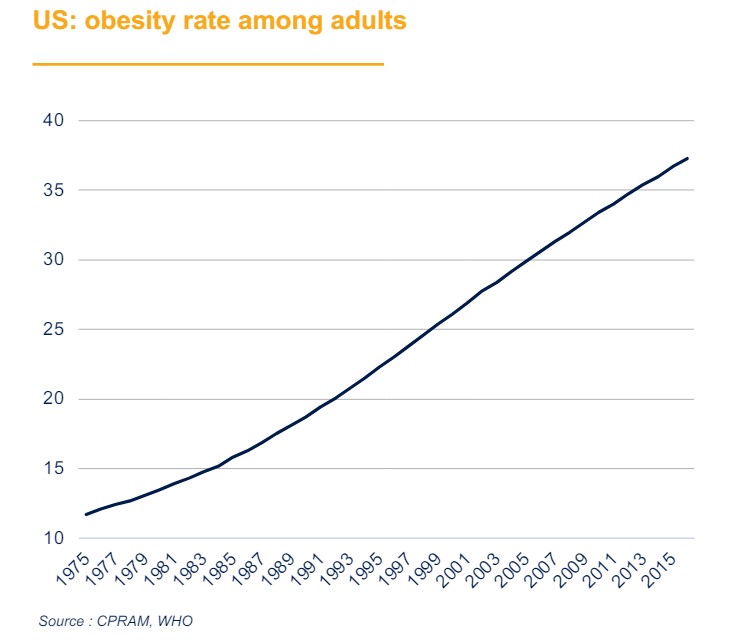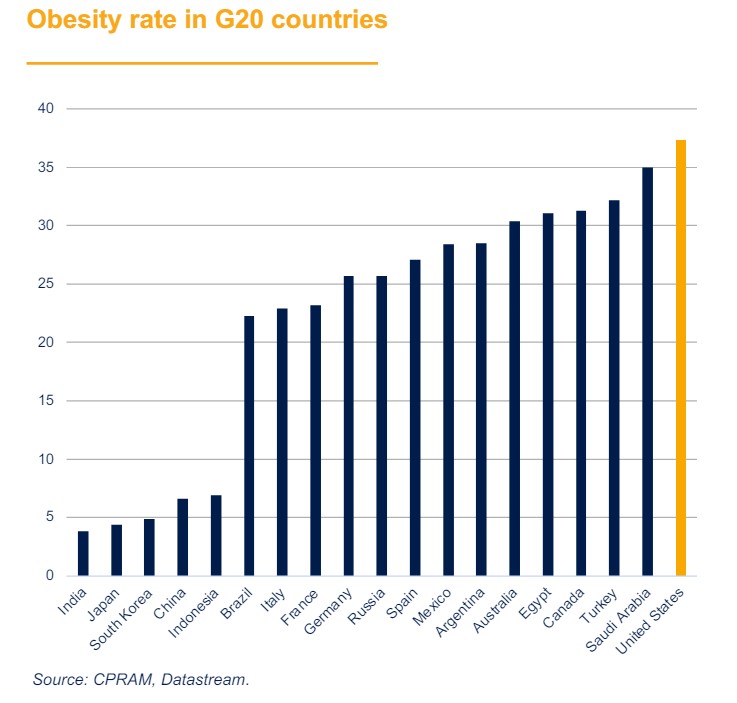The medical and economic impact of obesity
Obesity and new obesity treatments have hit the headlines in 2023, triggering significant market shifts. We will discuss trends in obesity and its economic and medical consequences.
Publié le 15 November 2023

What is obesity?
A person is generally said to be obese when his/her body mass index (defined as a person's weight in kilograms divided by the square of his/her height in meters) exceeds 30, and to be overweight when it exceeds 25.
How has obesity trended?
According to the World Health Organisation (WHO), the global rate of obesity tripled between 1975 and 2016. 39% of adults were overweight in 2016 and 13% were obese. No country has been spared, and low-income countries are where the obesity rate has risen the most in recent years. Obesity has risen in both women and men, and has also risen sharply in children and teenagers. The WHO says this trend by the increased consumption of sugar- and fat-rich foods and by lower physical activity (with work being increasingly sedentary, changes in transport means, and increasing urbanisation).
The Covid period and the restrictions it induced seem to have exacerbated obesity and overweightness, at least temporarily.
In the United States, obesity has worsened in recent decades. According to WHO figures, the US obesity rate rose from 11.7% in 1975 to 37.3% in 2016 (vs. 26.1% in 2000). The US is one of the countries with the highest obesity rates (surpassed only by Pacific island nations), and it is far ahead of all other G20 countries.


Are all types of people affected in the same way?
Recent studies1 have found an inverse correlation between income levels and obesity rates, something that did not truly exist before the 1990s. Remarkably, on a countrywide basis, the inverse correlation between obesity and income is significantly more pronounced among women than men.
The fact that obesity disproportionately affects poor people in rich countries has sometimes been called the “poverty-obesity paradox”. This may be due to the fact that high-quality foods cost more than low-quality ones or to the fact that disadvantaged persons do not live close to shops selling quality food. It has also been observed that disadvantaged areas are, on average, associated with higher sedentary rates.
What is the outlook for obesity?
The World Obesity Atlas forecasts that the rate of overweightness and obesity will continue to rise worldwide and even that half of the world’s population will be overweight by 2035 (with an obesity rate of 24%). According to these forecasts, obesity is therefore likely to gain ground.

What is the health impact of obesity?
Obesity and overweightness promote many noncommunicable pathologies, such as cardiovascular diseases, high blood pressure, strokes, some types of cancers and diabetes, and pulmonary diseases. An estimated more than 5 million deaths annually are said to be caused by non-communicable pathologies attributable to overweightness and obesity2.
What are the economic consequences of obesity?
Obesity and overweightness have both direct and indirect costs. Among the direct costs are medical costs (surgeries, medical tests and drugs) and non-medical ones, such as transport costs to obtain medical care. Among the indirect costs are those caused by premature death, health-related job absenteeism, and reduced productivity.
A study3 published in the scientific journal BMJ Global Health in 2022 found that the economic impact of obesity and overweightness amounted to 2.2% of global GDP and would likely rise further if obesity remained on its current trend. The public and private costs of obesity and overweightness are therefore huge.
1. Bentley A., Ormerod P. et D. Ruck, 2018, ” Recent origin and evolution of obesity-income correlation across the United States”, Nature
2. Murray C., Aravkin A., Zheng P., et al., 2020, “Global burden of 87 risk factors in 204 countries and territories, 1990–2019: a systematic analysis for the
global burden of disease study 2019”, The Lancet.
3. Okunogbe A., Nugent R., Spencer G. et al., 2022, “Economic impacts of overweight and obesity: current and future estimates for 161 countries”, BMJ
Global Health.